L3MBTL2
-
Official Full Name
l(3)mbt-like 2 (Drosophila) -
Overview
Lethal(3)malignant brain tumor-like 2 protein is a protein that in humans is encoded by the L3MBTL2 gene. -
Synonyms
L3MBTL2;l(3)mbt-like 2 (Drosophila);lethal(3)malignant brain tumor-like protein 2;dJ756G23.3;DKFZP761I141;H l(3)mbt l;3bt like 2 protein;3bt like protein;H-l(3)mbt-like protein 2;H-l(3)mbt-like protein;Hl;Hl(3)mbt like protein;Hl(3)mbtl;L;l(3)mbt like 2 (Drosophila);l(3)mbt like 2;L(3)mbt-like 2 protein;L(3)mbt-like protein 2;Lethal;Lethal(3)malignant brain tumor-like 2 protein;LMBL2_HUMAN;OTTHUMP00000198763;OTTHUMP00000198764;L3MBT;H-l(3)mbt-l
Recombinant Proteins
- Zebrafish
- Chicken
- Rat
- Mouse
- Human
- Mammalian Cells
- HEK293
- His
- Non
- DDK
- Myc
- Avi
- Fc
| Cat.# | Product name | Source (Host) | Species | Tag | Protein Length | Price |
|---|---|---|---|---|---|---|
| L3MBTL2-10389Z | Recombinant Zebrafish L3MBTL2 | Mammalian Cells | Zebrafish | His |
|
|
| L3MBTL2-1385C | Recombinant Chicken L3MBTL2 | Mammalian Cells | Chicken | His |
|
|
| L3MBTL2-3340R | Recombinant Rat L3MBTL2 Protein | Mammalian Cells | Rat | His |
|
|
| L3MBTL2-8917M | Recombinant Mouse L3MBTL2 Protein | Mammalian Cells | Mouse | His |
|
|
| L3MBTL2-373HCL | Recombinant Human L3MBTL2 lysate | HEK293 | Human | Non |
|
|
| L3MBTL2-171H | Recombinant Human L3MBTL2 Protein, MYC/DDK-tagged | HEK293 | Human | DDK&Myc |
|
|
| L3MBTL2-2996R | Recombinant Rat L3MBTL2 Protein, His (Fc)-Avi-tagged | HEK293 | Rat | Avi&Fc&His |
|
|
| L3MBTL2-2996R-B | Recombinant Rat L3MBTL2 Protein Pre-coupled Magnetic Beads | HEK293 | Rat |
|
||
| L3mbtl2-3744M | Recombinant Mouse L3mbtl2 Protein, Myc/DDK-tagged | HEK293 | Mouse | DDK&Myc |
|
|
| L3MBTL2-4971M | Recombinant Mouse L3MBTL2 Protein, His (Fc)-Avi-tagged | HEK293 | Mouse | Avi&Fc&His |
|
|
| L3MBTL2-4971M-B | Recombinant Mouse L3MBTL2 Protein Pre-coupled Magnetic Beads | HEK293 | Mouse |
|
Background
What is L3MBTL2 Protein?
L3MBTL2, also called L3MBT-like protein 2, is part of the PRC1-like 4 complex, playing a key role in shutting down gene expression and keeping chromatin tightly packed. It helps set up a repressive chromatin environment by working alongside H2AK119ub1 without relying on other histone modifications. L3MBTL2 is often found hanging around transcription start sites and teams up with E2F6 to control genes across the genome. When L3MBTL2 is knocked out, target genes get a boost in expression, and there's a noticeable drop in H2AK119ub1, making it essential to keeping chromatin in a repressed state. In cancer, especially pancreatic cancer, L3MBTL2 can dampen the effects of certain downstream genes like CGA, tweaking processes like autophagy. This highlights L3MBTL2's dual role in normal cellular workings and its impact on cancer progression.
What is the Function of L3MBTL2 Protein?
L3MBTL2, a key player in the Polycomb repressive complex 1 (PRC1)-like 4, acts as a chromatin regulator and transcriptional repressor, crucial for silencing gene expression. It helps in the monoubiquitination of histone H2A at lysine 119 (H2AK119ub1), which is essential for creating repressive chromatin structures. L3MBTL2 teams up with transcription factors like E2F6 and proteins such as CBX3/HP1γ, mainly targeting genes around transcription start sites. When L3MBTL2 is absent, target genes ramp up their expression, highlighting its gene-silencing role. Besides controlling transcription, L3MBTL2 also keeps cellular stress in check, for instance, guarding against kidney damage by stopping the DNA damage–p53–apoptosis pathway in kidney cells. Importantly, it's linked to tumor growth, especially in pancreatic cancer, by affecting autophagy and shutting down the transcription of certain genes, thus influencing cancer-related cellular activities.
L3MBTL2 Related Signaling Pathway
The L3MBTL2 protein is a key player in managing gene expression and epigenetic control, mainly through its role in the non-canonical Polycomb Repressive Complex 1, or PRC1.6. It's involved in silencing genes by compacting chromatin and encouraging histone methylation. L3MBTL2 is known to repress genes like IFIT2, boosting the PRC1.6 complex's ability to silence transcription, which is vital for its function as a tumor suppressor. It's also connected to controlling autophagy in cancer, as it suppresses CGA transcription, affecting pathways like PI3K/Akt/mTOR and TP53INP2, which can impact the progression of pancreatic cancer. This highlights L3MBTL2's broad influence on cellular processes, emphasizing its importance in both gene regulation and maintaining cellular balance, especially in cancer contexts.
L3MBTL2 Related Diseases
L3MBTL2 protein is tied to several diseases, especially in cancer and kidney injury scenarios. This protein shows up quite a bit in cancers like lung, liver, breast, skin melanoma, and stomach adenocarcinoma, with higher levels often seen there. In pancreatic cancer, L3MBTL2 is involved in silencing the glycoprotein hormone alpha subunit (CGA) by partnering with PRC1.6 complexes, which affects autophagy and helps tumors grow. On the kidney health front, L3MBTL2 seems to protect against injury by blocking pathways associated with DNA damage and apoptosis in kidney cells, hinting at its role in renal conditions. Plus, its function in shutting down gene expression through transcriptional repression and chromatin tightening makes it relevant in developmental disorders and cancers. All in all, L3MBTL2 plays a significant part in both cancer and kidney disease, emphasizing its broader influence in health and disease contexts.
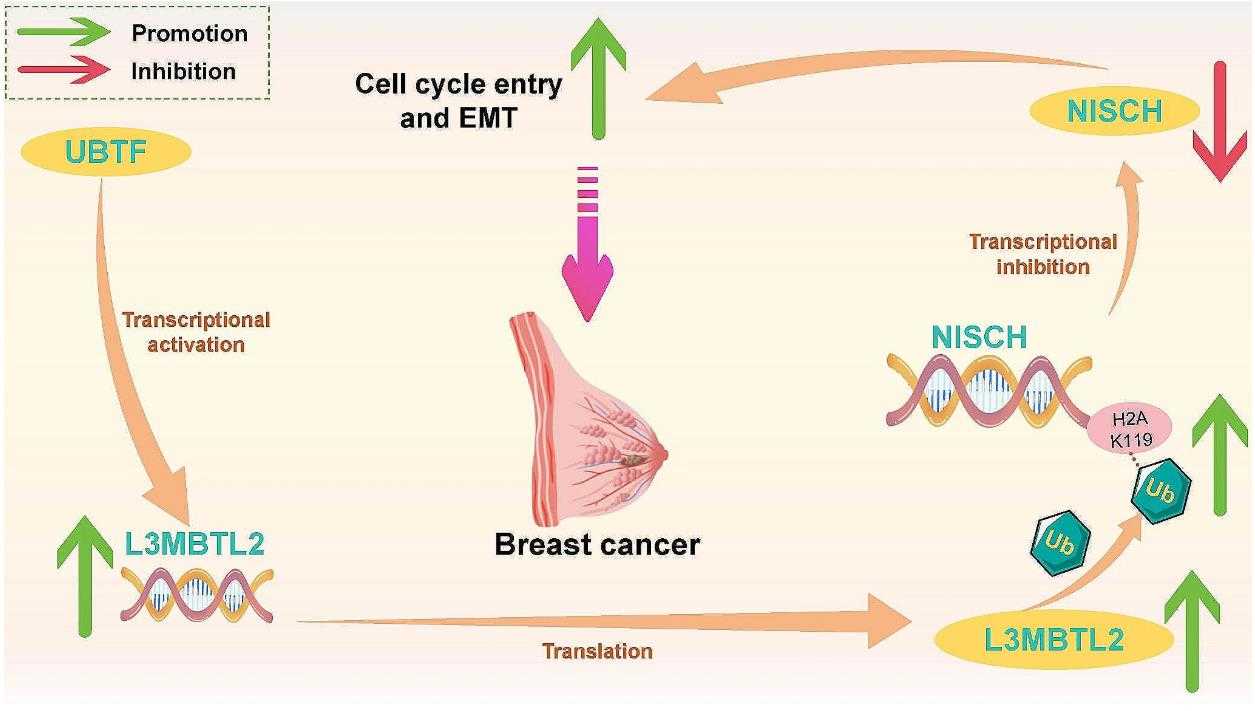
Fig1. A schematic representation of UBTF activation of L3MBTL2 to mediate H2AK119 monoubiquitination on the NISCH promoter. (Kun Chen, 2024)
Bioapplications of L3MBTL2
L3MBTL2 is a versatile protein with diverse bioapplications, especially in scientific research and industry. In research, it's key for studying how genes are epigenetically regulated and how chromatin is remodeled, being part of unique Polycomb repressive complexes (like PRC1) that silence genes by modifying histones. This makes it important for exploring gene regulation and the impact of histone changes on various cell activities. On the industrial side, particularly in biopharma, L3MBTL2 is looked at for developing cancer treatments, as it's regarded as a tumor suppressor in osteosarcoma, with its levels linked to patient outcomes. Promoting its activity, potentially with compounds like arsenic trioxide, could help curb tumor growth by boosting its ability to silence genes. Additionally, its role in reducing DNA damage from treatments like cisplatin points to potential applications in kidney and cancer therapies. Research on its function in sperm development also offers insights into reproductive health and possible treatments for male infertility. All in all, L3MBTL2 proves significant across basic science and biomedicine, stretching from gene regulation studies to cancer and fertility treatments.
Case Study
Case Study 1: Patrick Trojer, 2011
We found that the human protein L3MBTL2 is a key part of a protein group we named PRC1-like 4 (PRC1L4) because it includes Polycomb group (PcG) proteins like RING1, RING2, and PCGF6/MBLR. This complex also has E2F6 and CBX3/HP1γ, which are involved in turning off gene transcription. For PRC1L4 to work, L3MBTL2 is needed to compact chromatin without changing histones. By mapping its location across the genome, we saw L3MBTL2 and E2F6 binding to hundreds of genes, mostly around the start sites for transcription, and these genes didn't much overlap with those targeted by other E2F proteins or L3MBTL1, which connects with RB1. Knocking down L3MBTL2 with RNA interference led to higher expression of these target genes and a notable drop in the monoubiquitination of H2A lysine 119.
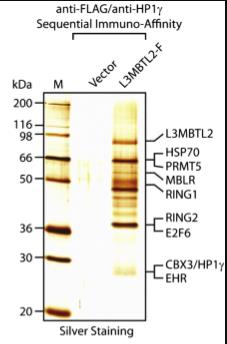
Fig1. Purified L3MBTL2-F protein complex was resolved by gradient SDS-PAGE and visualized by silver staining.
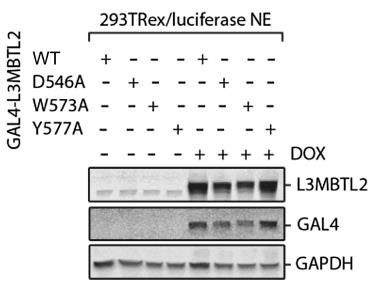
Fig2. Expression constructs encoding GAL4 fusion proteins containing L3MBTL2, either wild-type (WT) or with single amino acid substitutions.
Case Study 2: Hua Huang, 2022
L3MBTL2 is a key part of the ncPRC1.6 complex, and it's known for suppressing transcription and compacting chromatin, though its full role isn't entirely clear. In our research, we discovered L3MBTL2 acts as an oncogene in tumor growth by suppressing the gene CGA through a mechanism involving H2AK119ub1. The MGA/MAX heterodimer binds to the E-box on the CGA promoter, helping L3MBTL2 selectively repress CGA, which usually serves as a tumor suppressor in pancreatic ductal adenocarcinoma (PDAC). Specifically, CGA-transcript1 (T1) turned out to be the main transcript, with its tumor-suppressing ability relying on glycosylation. Glycosylated CGA-T1 helps fight PDAC by hindering autophagy through pathways like PI3K/Akt/mTOR and TP53INP2.
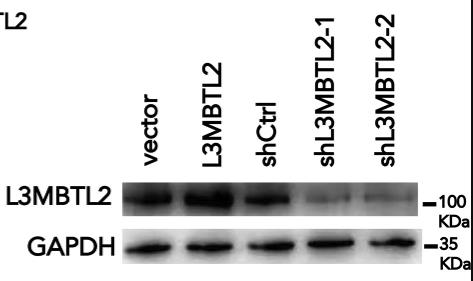
Fig3. The overexpression and knockdown of L3MBTL2 in PANC-1 cells were confirmed by qPCR and western blotting.
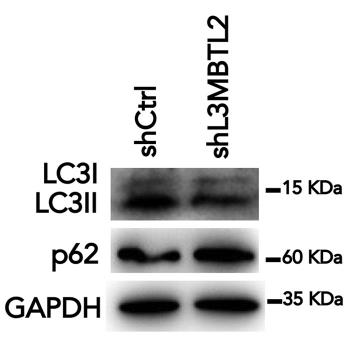
Fig4. Western blotting analysis of LC3II and P62 expression in shL3MBTL2 cells.
Involved Pathway
L3MBTL2 involved in several pathways and played different roles in them. We selected most pathways L3MBTL2 participated on our site, such as , which may be useful for your reference. Also, other proteins which involved in the same pathway with L3MBTL2 were listed below. Creative BioMart supplied nearly all the proteins listed, you can search them on our site.
| Pathway Name | Pathway Related Protein |
|---|
Protein Function
L3MBTL2 has several biochemical functions, for example, histone binding,methylated histone binding,protein binding. Some of the functions are cooperated with other proteins, some of the functions could acted by L3MBTL2 itself. We selected most functions L3MBTL2 had, and list some proteins which have the same functions with L3MBTL2. You can find most of the proteins on our site.
| Function | Related Protein |
|---|---|
| histone binding | RNF20,NASP,RAG1,HIST1H3C,HIST1H47,UHRF1,JAK2,H3F3A,L3MBTL1,HIST1H4I |
| methylated histone binding | DPPA3,CHD1,PHF8,ING2,KDM4A,CAPNS2,MTF2,CBX5,CCDC101,MSL3 |
| protein binding | GRID2IP,RPS6,DIEXF,SOX6,CFH,MYOG,CREM,APEX1,HSD17B10,IFNAR2 |
| zinc ion binding | TCEA2,CAR7,BTR22,UHRF1,MMP25,KIAA0913,ZRANB1,PHF17,MT1X,ZSWIM1 |
Interacting Protein
L3MBTL2 has direct interactions with proteins and molecules. Those interactions were detected by several methods such as yeast two hybrid, co-IP, pull-down and so on. We selected proteins and molecules interacted with L3MBTL2 here. Most of them are supplied by our site. Hope this information will be useful for your research of L3MBTL2.
HDAC3;TRIM42;PAICS;AES;TBC1D9B;PHF10
Resources
Related Services
Related Products
References
- Stielow, C; Stielow, B; et al. SUMOylation of the polycomb group protein L3MBTL2 facilitates repression of its target genes. NUCLEIC ACIDS RESEARCH 42:3044-3058(2014).
- Iurlaro, M; Ficz, G; et al. A screen for hydroxymethylcytosine and formylcytosine binding proteins suggests functions in transcription and chromatin regulation. GENOME BIOLOGY 14:-(2013).


